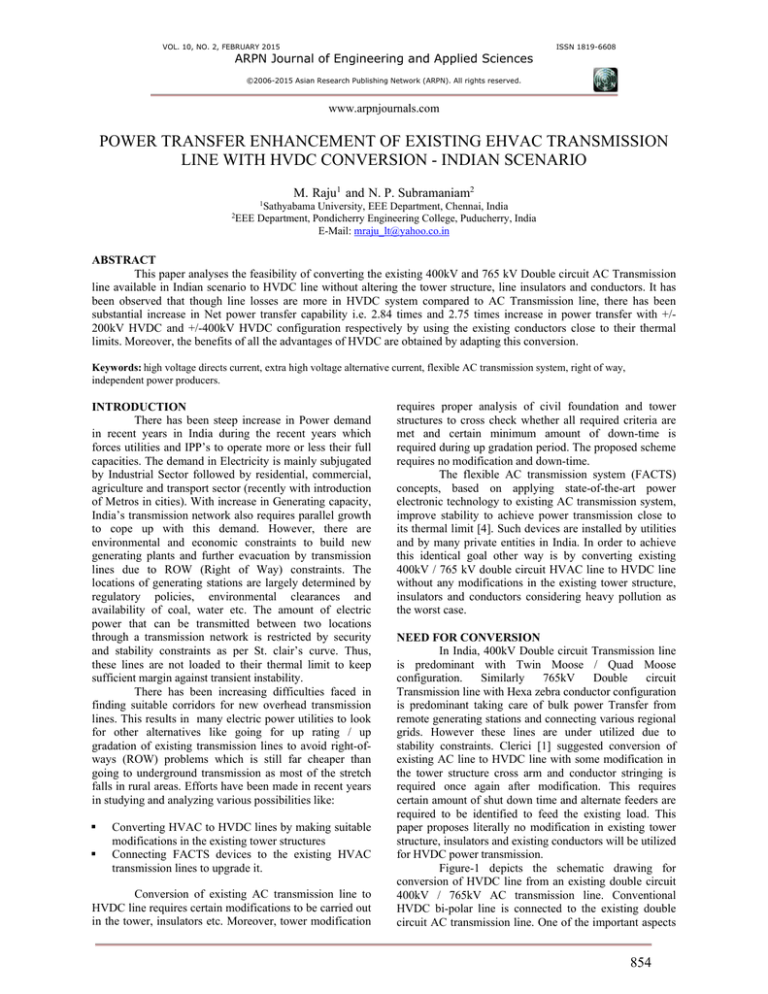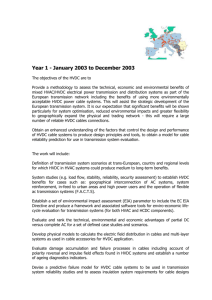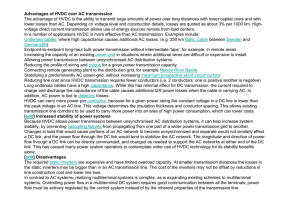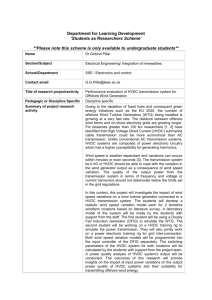
VOL. 10, NO. 2, FEBRUARY 2015
ARPN Journal of Engineering and Applied Sciences
ISSN 1819-6608
©2006-2015 Asian Research Publishing Network (ARPN). All rights reserved.
www.arpnjournals.com
POWER TRANSFER ENHANCEMENT OF EXISTING EHVAC TRANSMISSION
LINE WITH HVDC CONVERSION - INDIAN SCENARIO
M. Raju1 and N. P. Subramaniam2
2EEE
1Sathyabama
University, EEE Department, Chennai, India
Department, Pondicherry Engineering College, Puducherry, India
E-Mail: mraju_lt@yahoo.co.in
ABSTRACT
This paper analyses the feasibility of converting the existing 400kV and 765 kV Double circuit AC Transmission
line available in Indian scenario to HVDC line without altering the tower structure, line insulators and conductors. It has
been observed that though line losses are more in HVDC system compared to AC Transmission line, there has been
substantial increase in Net power transfer capability i.e. 2.84 times and 2.75 times increase in power transfer with +/200kV HVDC and +/-400kV HVDC configuration respectively by using the existing conductors close to their thermal
limits. Moreover, the benefits of all the advantages of HVDC are obtained by adapting this conversion.
Keywords: high voltage directs current, extra high voltage alternative current, flexible AC transmission system, right of way,
independent power producers.
INTRODUCTION
There has been steep increase in Power demand
in recent years in India during the recent years which
forces utilities and IPP’s to operate more or less their full
capacities. The demand in Electricity is mainly subjugated
by Industrial Sector followed by residential, commercial,
agriculture and transport sector (recently with introduction
of Metros in cities). With increase in Generating capacity,
India’s transmission network also requires parallel growth
to cope up with this demand. However, there are
environmental and economic constraints to build new
generating plants and further evacuation by transmission
lines due to ROW (Right of Way) constraints. The
locations of generating stations are largely determined by
regulatory policies, environmental clearances and
availability of coal, water etc. The amount of electric
power that can be transmitted between two locations
through a transmission network is restricted by security
and stability constraints as per St. clair’s curve. Thus,
these lines are not loaded to their thermal limit to keep
sufficient margin against transient instability.
There has been increasing difficulties faced in
finding suitable corridors for new overhead transmission
lines. This results in many electric power utilities to look
for other alternatives like going for up rating / up
gradation of existing transmission lines to avoid right-ofways (ROW) problems which is still far cheaper than
going to underground transmission as most of the stretch
falls in rural areas. Efforts have been made in recent years
in studying and analyzing various possibilities like:
Converting HVAC to HVDC lines by making suitable
modifications in the existing tower structures
Connecting FACTS devices to the existing HVAC
transmission lines to upgrade it.
Conversion of existing AC transmission line to
HVDC line requires certain modifications to be carried out
in the tower, insulators etc. Moreover, tower modification
requires proper analysis of civil foundation and tower
structures to cross check whether all required criteria are
met and certain minimum amount of down-time is
required during up gradation period. The proposed scheme
requires no modification and down-time.
The flexible AC transmission system (FACTS)
concepts, based on applying state-of-the-art power
electronic technology to existing AC transmission system,
improve stability to achieve power transmission close to
its thermal limit [4]. Such devices are installed by utilities
and by many private entities in India. In order to achieve
this identical goal other way is by converting existing
400kV / 765 kV double circuit HVAC line to HVDC line
without any modifications in the existing tower structure,
insulators and conductors considering heavy pollution as
the worst case.
NEED FOR CONVERSION
In India, 400kV Double circuit Transmission line
is predominant with Twin Moose / Quad Moose
configuration.
Similarly
765kV
Double
circuit
Transmission line with Hexa zebra conductor configuration
is predominant taking care of bulk power Transfer from
remote generating stations and connecting various regional
grids. However these lines are under utilized due to
stability constraints. Clerici [1] suggested conversion of
existing AC line to HVDC line with some modification in
the tower structure cross arm and conductor stringing is
required once again after modification. This requires
certain amount of shut down time and alternate feeders are
required to be identified to feed the existing load. This
paper proposes literally no modification in existing tower
structure, insulators and existing conductors will be utilized
for HVDC power transmission.
Figure-1 depicts the schematic drawing for
conversion of HVDC line from an existing double circuit
400kV / 765kV AC transmission line. Conventional
HVDC bi-polar line is connected to the existing double
circuit AC transmission line. One of the important aspects
854
VOL. 10, NO. 2, FEBRUARY 2015
ARPN Journal of Engineering and Applied Sciences
ISSN 1819-6608
©2006-2015 Asian Research Publishing Network (ARPN). All rights reserved.
www.arpnjournals.com
of this conversion is that there is no modification
envisaged in tower structure, insulator and conductor. One
pole of the DC line is connected to one of the AC circuit
and another pole is connected to second circuit. DC
current can be allowed to flow through the circuit and the
only constraint being the thermal limit of the conductor. In
this paper, two cases after HVDC conversion have been
analyzed. First case will be with 400kV double circuit
twin moose and quad moose transmission line. Second
case will be with 765kV double circuit with hexa zebra
conductor configuration.
430mm total creepage arrived at 9890mm. However with
DC lines even by considering heavy pollution as the worst
case, 47mm/kV and the same disc insulator arrangement
with 200kV DC works out to be 9870mm considering
210kV as highest voltage. From the above it is evident that
creepage requirement of HVDC is getting satisfied with the
existing insulator string.
CRITERIA FOR EXISTING HVAC TO HVDC LINE
As there is no change made in the conductors, the
total continuous rated current remains the same i.e. the
power transmitted increases proportionally to the newly
adapted DC line to ground voltage.
Figure-1. Basic scheme for HVAC to HVDC conversion.
Case-1: 400kV transmission line
i) As insulators remain unchanged, the peak
voltage in both cases should be equal
Vmax = √2 Vph = Vd
(1)
Considering existing 400kV AC line, HVDC
transmitting voltage shall be restricted to +/-200kV.
ii) Each conductor is to be insulated for Vmax in
case of AC line. However for DC line, conductor-toconductor separation distance within the circuit of each line
is not required since the entire circuit is used for one pole.
The available clearances in existing double circuit AC line
and required clearance for Bipolar DC line is compared as
per Figure-2 in conjunction with Table-1 and found
sufficient with above voltage level.
iii) In case of AC line considering heavy
pollution, existing lines containing 23 nos of disc insulator
per string and individual disc insulator having creepage of
Figure-2. Tower clearance drawing.
iv) Corona losses of converted DC line are very
much lower in the range of 1kw/km compared to original
AC lines in 400kV which is in the range of 17kw/km.
v) Since the conversion scheme adapted does not
involve any modification in tower structure and conductor,
there is no need to check the adequacy of mechanical
strength of tower and its civil foundation.
855
VOL. 10, NO. 2, FEBRUARY 2015
ISSN 1819-6608
ARPN Journal of Engineering and Applied Sciences
©2006-2015 Asian Research Publishing Network (ARPN). All rights reserved.
www.arpnjournals.com
Table-1. AC and DC clearance comparison check.
Reference
Voltage
Cond
D
420kV AC
420kV AC
420kV AC
+/- 200kV
DC
Quad
Twin
8600
8000
4200
800kV AC
800kV AC
+/- 400kV
DC
Hexa
400kV Line
Std Tower
Min.
Clearance as
per CBIP
765kV Line
Std Tower
CBIP
Case-2: 765kV double circuit transmission line
E
S
(Dimensions in mm)
3050
13412
9065
3050
13412
9065
3050
8950
-
620
-
6810
15000
9400
4400
4400
13641
-
15225
12550
-
1960
-
8720
Table-2. AC Line parameters.
i) Using Equation (1) considering existing 765kV
AC line, HVDC transmitting voltage shall be restricted to
+/-400kV.
Line configuration
ii) Similarly the available clearances in existing
double circuit AC line and required clearance for Bipolar
DC line is compared as per Figure-2 in conjunction with
Table-1 and found sufficient with above voltage level.
400kV Twin moose
D/C
400kV Quad moose
D/C
765kV Hexa zebra
D/C
iii) In case of AC line considering heavy
pollution, existing lines containing 47 nos of disc insulator
per string and individual disc insulator having creepage of
430mm, total creepage arrived at 20210mm. However with
DC lines even by considering heavy pollution as the worst
case, 47mm/kV and the same disc insulator arrangement
with 400kV DC works out to be 19740mm considering
420kV as highest voltage. From the above it is evident that
creepage requirement of HVDC is getting satisfied with the
existing insulator string.
iv) Corona losses of converted DC line are very
much lower in the range of 3kw/km compared to original
AC lines in 765kV which is in the range of 45kw/km.
v) In this case also, there is no need to check the
adequacy of mechanical strength of tower and its civil
foundation as the conversion scheme adapted does not
involve any modification in tower structure and conductor.
CASE STUDY - ANALYSIS
A) Before conversion - AC System
The loadability of ACSR Moose, twin bundle
conductor and quad bundle conductor, 400-kV, double
circuit line and ACSR Zebra, Hexa bundle, 765kV, 50-Hz,
300-km has been analyzed. The Line parameters [7] (per
unit / km / circuit, at 100 MVA base) are given in Table-2.
H
Positive sequence (per unit /
km/ckt)
R
X
B
1.800E- 1.923E6.02E-3
5
4
9.177E- 1.582E7.33E-3
6
4
2.096E- 4.360E2.66E-2
6
5
The total power transfer through the double circuit
line before conversion is as follows:
PAC = 3Vph2 sin
1 / X
(2)
where X is the transfer reactance per phase of the double
circuit line, and ∂1 is the power angle between the voltages
at the two ends. To keep sufficient stability margin, ∂1 is
generally kept low and it does not exceeds 30. With the
increasing length of line, the loadability of the line is
decreased [5]. An approximate value of ∂1 may be
computed from the loadability curve by knowing the values
of Surge Impedance Loading (SIL) and transfer reactance
X of the line.
PAC = 2 M SIL
(3)
where M is the multiplying factor and its magnitude
decreases with the length of the line. The value of M can be
obtained from loadability curve [5].
Transfer reactance X of twin moose D/C and quad
moose D/C line is estimated as 46.15 and 37.968 ohms
respectively for 400kV line. Similarly for 765kV Line,
Transfer reactance X of Hexa zebra D/C line is estimated
as 38.27 ohms. Current carrying capacity of each ACSR
Moose sub-conductor = 0.8kA for 400kV line. In case of
765kV line, Current carrying capacity of each ACSR Zebra
sub-conductor = 0.65kA
856
VOL. 10, NO. 2, FEBRUARY 2015
ARPN Journal of Engineering and Applied Sciences
ISSN 1819-6608
©2006-2015 Asian Research Publishing Network (ARPN). All rights reserved.
www.arpnjournals.com
Ither=1.6kA and SIL= 515 MW/Ckt; 400kV twin bundle (4)
Ither=3.2kA and SIL=650 MW/Ckt; 400kV quad bundle (5)
Ither=5.2kA and SIL=2250MW/Ckt; 765kV hexa bundle (6)
Even though power transfer rating is much higher,
the values are restricted due to limitations in SIL as
indicated above. Approximate value of AC current per
phase per circuit of the double circuit line may be
computed as
Ia = PAC / √3 VL cos φ
(7)
Power loss for each line =
PLoss 3I 2 R
(8)
B) After HVDC conversion
Using equation (1), we are choosing
Vd=+/- 200kV for 400kV Tower and +/- 400kV
for 765kV Tower. Now, allowing the net current through
the conductor equal to its thermal limit Ither. Thus DC
current (Id) obtained is as follows.
Id = 1.6kA - for twin bundle
(9)
Id = 3.2kA - for quad bundle
(10)
Id = 5.2kA - for hexa bundle
(11)
The total power transfer through the double circuit
line after conversion is as follows:
PDC = 6Vd Id
(12)
Power loss for each line = 6 Id2 R
(13)
The analysis after HVDC conversion is made for
all three phases per circuit utilized for one DC pole and the
configuration will be HVDC Bi-pole arrangement with
conventional ground return path. The arrangement will be
as shown in Figure-3.
Figure-3. Tower with HVDC configuration.
COMPARISON ON TRANMSSION LINE
CAPACITY
The details tabulated in Table-3 shows the
comparison on transmission line capacity and losses for
400kV double circuit twin moose / quad moose line
converted to +/- 200kV HVDC line by applying the above
equations discussed with all three phases in one circuit
utilized for one DC pole and another three phase circuit for
other DC pole.
Table-3. AC / DC line capacity comparison - HVAC 400kV to HVDC +/- 200kV Conversion.
Parameter
Power transfer
capability (MW)
Line loss (MW)
Net power transfer
(MW)
Increase in power
transfer
Twin Moose D/C line
HVAC
HVDC +/00kV
200kV
Quad Moose D/C line
HVAC
HVDC +/400kV
200kV
1030
1920
1300
3840
47.5
127.9
37.8
255.8
982.5
1792.1
1262.2
3584.2
1.82
2.84
857
VOL. 10, NO. 2, FEBRUARY 2015
ARPN Journal of Engineering and Applied Sciences
ISSN 1819-6608
©2006-2015 Asian Research Publishing Network (ARPN). All rights reserved.
www.arpnjournals.com
The details tabulated below are the comparison on
transmission line capacity and losses for 765kV double
circuit Hexa zebra line converted to +/- 400kV HVDC line
by applying the above equations discussed with all three
phases in one circuit utilized for one DC pole and another
three phase circuit for other DC pole.
Table-4. AC / DC line capacity comparison - HVAC
765kV to HVDC +/- 400kV Conversion.
Parameter
Power transfer
capability (MW)
Line loss (MW)
Net power transfer
(MW)
Increase in power
transfer
Hexa Zebra D/C line
HVAC 765kV HVDC +/- 400kV
4500
12480
47.3
254.92
4452.7
12225.1
2.75
CONCLUSIONS
The feasibility to convert existing AC
transmission line to a HVDC line has been discussed. For
the particular transmission line studied, there is substantial
increase in the loadability of the line. The line can also be
loaded to its thermal limit without any restriction due to
HVDC current. There is no need for any modification in
the size of conductors, insulator strings, and towers
structure of the original line and it is also evident from the
above Tables 3 and 4 that conversion with 400kV quad
moose line has got more advantage as more power can be
transferred compared to conversion with other lines. Such
an arrangement of conductor configuration can be looked
into, while designing new HVDC transmission lines
instead of going for more number of conductors per bundle
per pole.
[5] P.S. Kundur. 1994. Power System Stability and
control. New York; MC-Graw-Hill.
[6] K.R. Padiayar. 1993. HVDC Transmission system.
New Delhi, India; Wiley Eastern.
[7] Manual on Transmission planning criteria, Jan-2013.
Central Electricity Authority, New Delhi, India.
[8] CBIP Manual on Transmission Line Towers. New
Delhi, India.
[9] H. Rahman and B.H. Khan. 2008. Stability
improvement of power system by simultaneous ACDC power Transmission. Electrical Power Systems
Research. 78: 756-764.
[10] L.K. Gyugyi. 1995. Unified Power flow controller; a
new approach to power transmission control. IEEE
Trans. Power Delivery. 10(2): 1085-1097.
[11] D. Marene Larruskain, Inmaculada Zamora, Oihane
Abarrategui, Zaloa Aginako. 2011. Conversion of AC
distribution Lines into DC lines to upgrade
transmission capacity. Electrical Power systems
Research 81, Science Direct. pp. 1341-1348.
[12] M.I. Khan, R.C. Agrawal. 2005. Conversion of AC
Line into HVDC. IEEE PES 2005 conference and
Exposition in Africa, Durban, South Africa.
[13] D.M. Larruskain, I. Zamora, O. Abarrategui, A.
Iraolagoitia, M.D. Gutierrez, E. Lorono, F. de la
Bodega. 2007. Power transmission capacity upgrade
of overhead lines. Electricity Today. 19(7): 32-36.
REFERENCES
[14] I. Albizu, A.J. Mazon, I. Zamora. 2005. Methods for
increasing the rating of over head lines. IEEE Power
Tech conference, Saint Ptersburg, Russia.
[1] A. Clerici, L. Paris and P. Danfors. 1991. HVDC
conversion of HVAC line to provide substantial
power upgrading. IEEE Transactions on Power
Delivery. 6(1): 324-333.
[15] T. Hayashi, M. Takasaki. 1998. Transmission
capability enhancement using power electronics
technologies for the future power system in Japan.
Electric Power systems Research. 44: 7-14.
[2] H. Rahman and B.H. Khan. 2007. Power upgrading
of Transmission Line by combining AC-DC
Transmission. IEEE Transactions on Power Systems.
22(1): 459-456.
[3] K.P. Basu and B.H.Khan. 2001. Simultaneous ACDC power transmission. Institute of Engineers (India)
J-EL. 82: 32-35.
[4] N.G. Hingorani. 1991. FACTS - Flexible AC
Transmission system. In Proc. Inst. Elect. Eng. 5th
International
conference
AC-DC
Power
Transmission, London, U.K.
858



